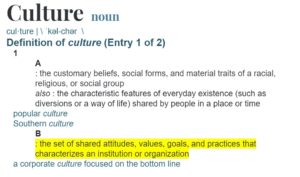How to Create a Place Where People Want to Work
Tips on Growing a Positive Workplace Culture

What is Culture?
A simple question. Of course you know what culture is but if you were asked to define it, what would you say? Before reading on, I want you to complete this sentence “Culture is…”
What did you come up with? Was it simple to define or a little tricky? Never fear. In this article we will explain what culture is, how to curate, craft, and construct it, and why it is essential in creating a workplace your employees want to work in.
To begin we will analyse the elements of a dysfunctional workplace or team. Then we can set some foundational terms for building culture and finally some simple action steps to take to grow your workplace to be an environment your employees are eager to engage in.
Let’s start with the basics:

“The set of shared attitudes, values, goals, and practises that characterizes an institution or organisation”.
Nice. And. Simple. Easy to define, hard to design. So before we move on to creating positive culture let’s look at the five elements of a negative workplace culture and how they arise.
In this article we will analyse Patrick Lencioni’s “5 Dysfunctions of a Team” (2002) as these five core concepts define what can be missing from a team, workplace, or company that result in unmet outcomes, low standards, and most importantly, poor employee satisfaction.
The 5 Dysfunctions of a Team
Below is the pyramid of dysfunction defined by Patrick Lencioni in his seminal book “The 5 Dysfunctions of a Team.
It lists the qualities inherent in groups that do not achieve results for themselves, their team, or the company at large. The hierarchy of principles show us that trust is fundamental to all of its above components. Without the foundational principles in play an employer cannot hope to achieve cohesion or outcomes in any of the above areas.

Source: Lencioni “5 Dysfunctions of a Team” (2002)
A strong cohesive workplace, team, or company need to be able to trust, discuss, and commit in order to achieve and believe. Now before you say “Ok thanks for the kilogram of cheese you just threw at me”, hear me out. The five dysfunctions listed above all boil down to a few simple ideas:
- When your employees do not trust themselves or one another they will avoid conflict, have trouble committing, refuse responsibility, and lose focus on the endgame
- If you do not have a clear vision then you rob your employees of purpose
- Culture is not built it is grown

What does building culture look like?
You’ve probably seen this at some point in time or another.
A “built” culture is one where there are policy documents, enforced social engagements, morale meetings, HR training, and the god forsaken “corporate team-building exercises”. When a company or organisation is out of touch with the needs and desires of its employees it will tend to “enforce” culture.
They will ignore the dysfunctions of their teams in favour of imposing group activities, or social meetings with the hope they will miraculously discover how fun it is to go to work because their bosses paid for the afternoon off. This is not positive workplace culture, this is enforced cohesion.
What does growing culture look like?
For our purposes we are going to boil culture down to three simple themes:
- Ideas
- Customs
- Social Behaviours
And we will examine how each of them, curated properly, can effectively grow a thriving, positive, and constructive workplace culture.
1. Ideas
Ideas encompass the values, strategies, goals, outcomes, and overall vision of the team. Without these no one knows what the hell they’re there for. In an effort to funnel tasks to specific employees managers can tend to tell their employees “what they need to know” hoping to remove any potentially distracting information that will deter the employee from effectively achieving their otherwise simple task.
For example the kid at McDonald’s whose job is to make sure the carpark area is kept clean and ordered doesn’t need to know about vision for the company right?

Wrong. There might be a handful of different ways to keep a carpark “clean and ordered” and without an idea of what McDonald’s vision for the customer experience is the employee may choose the method of approach counter to the goal of the task. They might decide the best way to achieve their goal is to water the garden at the beginning and end of every shift. Now while this is effectively achieving their assigned task it may work counter to the company’s vision of “Quality, service, cleanliness and value (qsc&v) for each and every customer, each and every time.”
When old mate is inadvertently watering down the gardens as well as hash browns of the customers as they head out the drive through for breakfast, this might not be in line with McDonald’s vision.
Now this is a humorous example of how not being aligned with or aware of a company’s vision can cause good employees to do bad work. If they know what the values, strategies, and goals of the organisation are they can reference them back to the task they have been assigned. When they have a question about the approach they may ask themselves, “how does does align with the overall values?”.
Having a solid understanding of the Ideas of a company goes a long way in having employees be able to trust their own decisions, and is the first step to growing a positive culture.
2. Customs
Customs are the traditions, rituals, shared experiences, and common knowledge that emerge from groups of cohesive individuals. Customs can be instilled, and to some extent designed, but the ones that remain are the ones that are created organically and by the employees themselves. For example, a company can organise a TGIF drinks session but if they set the event to occur after office hours, then only the employees who do not have anything on after work will attend. Without considering the needs of the individuals then the event will likely be a bust. Making participation compulsory will only serve to make your employees bitter they cannot leave the office even after their shift is over.

However if someone within the group decides to do friday karaoke after work, inviting all levels of management, then the door is open for individuals to choose their involvement. If the event is a success and people are interested then there might be a second event; before anyone knows it a tradition is born.
They key element to growing positive workplace culture through ideas and customs is empowering individuals to think and act for themselves. When you instill trust in your employees to work in alignment with the company’s vision, to make their own decisions, and give them room to allow self-organisation, you create a team of individuals who are willing and incentivised to work toward a collective goal. To foster such organic and emergent cohesion you, as the leader, need to plant seeds allowing social behaviour to develop on its own.
3. Social Behaviour
Social Behaviour is probably the most obvious display of culture of a workplace. It can also be an effective indicator of the type of culture in the workplace. Do the employees trust one another? Are there conversations happening interpersonally that go beyond tasks, goals, and objectives? Are your employees friends? Can your employees identify and resolve conflict? All of these are important considerations in determining the cultural temperature of the team, company, or organisation. Going back to the 5 Dysfunctions of a Team we see that trust, conflict resolution, commitment, taking responsibility, and clear vision are the 5 key methods in minimising dysfunction in teams.

As the leader you will need to foster an environment where employees can feel a sense of trust in their managers and colleagues.
If they feel supported by the company then they will feel more desire to have their opinions heard and in this way more willing to engage in conflict. Here it is important to foster an environment of constructive feedback, or nonjudgmental communication amongst employees. A trust in oneself will lead to employees speaking their min and, this helps an individual feel a sense of commitment to their role, after all they spoke their mind, were heard, and are now responsible for that opinion.
By encouraging commitment and responsibility an employee is empowered to feel they can affect positive change. When this desire is aligned with the vision of the company then the employee becomes an agent of the collective goal. They have a clearly defined (and more importantly felt) purpose within the organisation.
Finally, It Ends
TL:DR
“But creating a good culture goes well beyond the typical perks like annual bonuses and Hawaiian shirt Friday. It’s about establishing an atmosphere where people feel positive, purposeful, and engaged.” – Jennifer Russell
To grow a positive workplace culture you must empower your employees as individual autonomous agents capable of change. Trust in the company, the team, and the self are integral in allowing individuals to take charge and begin making informed decisions. When aligned with the overall vision and objective they can choose behaviours and actions that result in increased autonomy, productivity, responsibility, and purpose.
And when human beings feel a sense of purpose within a group they become excited to go to work and it is them who create the positive culture.






